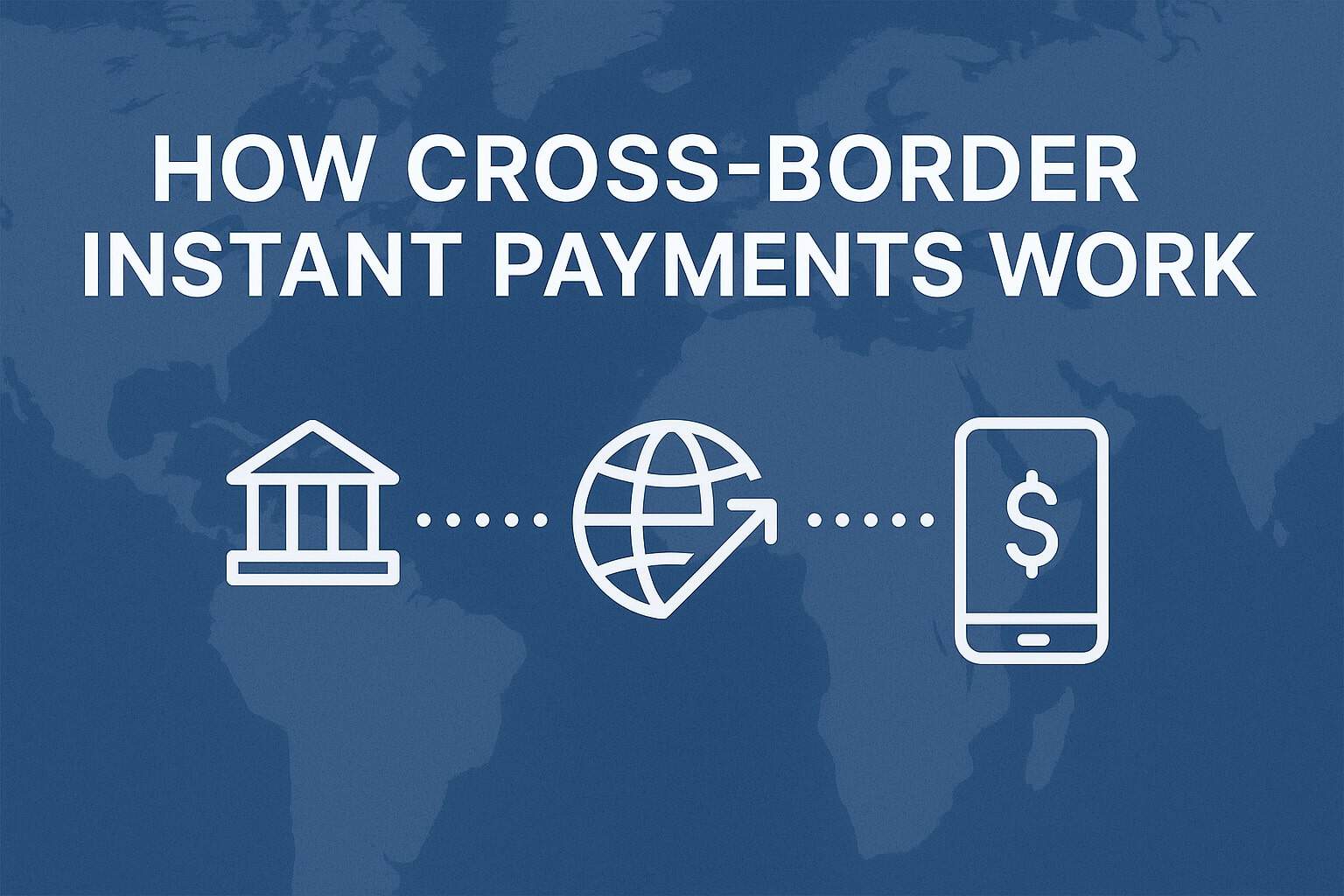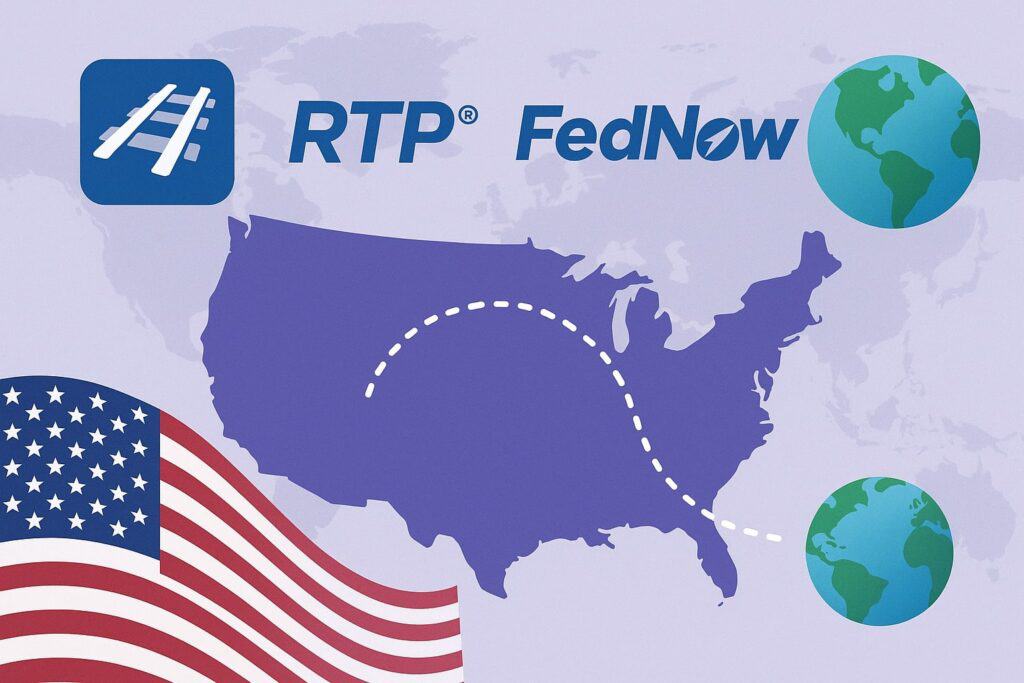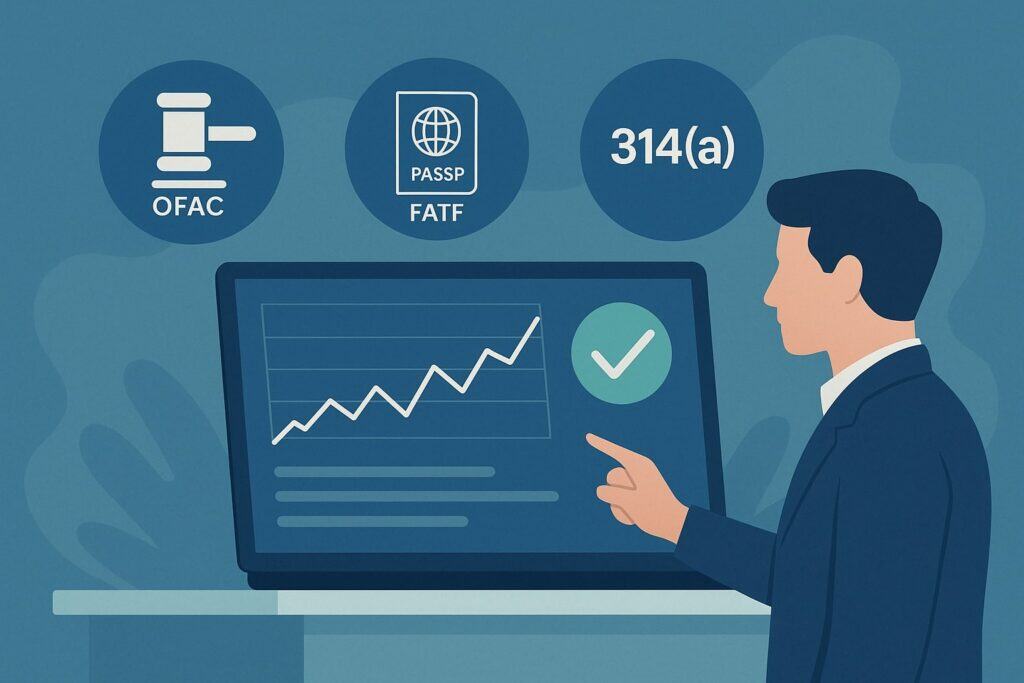
How Cross-Border Instant Payments Work
Cross-border instant payments are finally moving from pilot projects and marketing slides to daily reality. For U.S. businesses—from marketplaces and software platforms to exporters and global suppliers—this shift promises second-level speed, real-time tracking, richer data, and lower operational friction.
In this guide, we unpack how cross-border instant payments work end-to-end, what’s changing in 2025, and how U.S. firms can design a compliant, future-proof roadmap.
We draw on the latest developments in ISO 20022 data standards, FedNow and RTP® in the U.S., SEPA Instant in Europe, SWIFT’s gpi and pre-validation services, BIS “Nexus,” the IXB initiative, and mBridge’s multi-CBDC experiments, plus evolving AML/CFT and sanctions expectations.
What “Cross-Border Instant Payments” Actually Means

Cross-border instant payments are credit transfers that cross at least one national border and reach the beneficiary account (or wallet) within seconds, with confirmation and full data transparency.
“Instant” is more than speed: it assumes 24/7/365 operation, irrevocability after posting, finality, and rich remittance data so reconciliation doesn’t become tomorrow’s problem. In the U.S., “instant” rails include RTP® (The Clearing House) and FedNow® (Federal Reserve).
Internationally, instant rails include the EU’s SEPA Instant (SCT Inst), Singapore’s FAST/PayNow, Thailand’s PromptPay, India’s UPI, and others.
Interlinking those domestic instant systems—or bridging them through messaging networks and settlement arrangements—is what turns a domestic instant payment into a cross-border instant payment.
Instant also implies better transparency (end-to-end tracking), predictability (quotes and FX outcomes upfront), and data quality (ISO 20022 structured fields for names, addresses, purposes, and invoice references).
Those elements reduce rejects and manual repairs that slow traditional cross-border wires. SWIFT gpi brought global tracking and service-level expectations, and newer services like Payment Pre-validation help stop bad data before a payment even leaves the building.
The Building Blocks: Messaging, Clearing, and Settlement
Every cross-border instant payment has three layers: messaging, clearing, and settlement. Messaging is the instruction flow—who pays whom, how much, for what, with which fields.
Clearing is the exchange of obligations between institutions. Settlement is the transfer of funds between those institutions’ accounts at a settlement asset (central bank money, commercial bank money, or a tokenized form like wholesale CBDC). In practice, several models enable cross-border instant payments:
- Correspondent + Instant Hybrid: A U.S. bank sends an ISO 20022 message over SWIFT to a foreign bank; funds are made available instantly using the receiving country’s instant rail, while underlying interbank settlement occurs via correspondents and nostro/vostro accounts, often netted intraday. SWIFT gpi tracking helps manage visibility; pre-validation reduces rejections.
- Interlinked Instant Systems: Two domestic instant payment systems are linked via a scheme or hub. The PayNow–PromptPay linkage between Singapore and Thailand demonstrated retail cross-border instant payments using proxy addressing and FX at the edge. The BIS Project Nexus blueprint generalizes this model to many countries at once.
- Immediate Cross-Border (IXB): EBA CLEARING (EU), The Clearing House (U.S.), and SWIFT launched a pilot to deliver euro↔USD instant payments by bridging the EU’s RT1 and the U.S. RTP® network. The aim is true seconds-level availability across the corridor with harmonized rules and ISO 20022 formats.
- mBridge (multi-CBDC): For wholesale cross-border settlement, Project mBridge has reached an MVP stage, enabling participating central banks and commercial banks to test real-time cross-border settlement using wholesale CBDCs on a shared DLT platform.
While not production-scale yet, it shows how PvP (payment-versus-payment) and atomic FX can be embedded to eliminate time-zone and settlement risks.
The Role of ISO 20022, CBPR+, and Data Quality
Cross-border instant payments run on structured data. ISO 20022 is the global standard for that data, with SWIFT’s CBPR+ program migrating cross-border payments from legacy MT messages to ISO 20022 MX messages.
The coexistence period ends November 2025, so U.S. banks, PSPs, and corporates must be ready for full ISO data ingestion, screening, and reconciliation.
Benefits include more precise names and addresses, richer remittance (invoice-level details), and clearer regulatory screening fields. That drives higher straight-through processing (STP) and fewer false positives. SWIFT’s Transaction Manager orchestrates ISO flows during coexistence and beyond.
Good data starts before you hit Send. SWIFT Payment Pre-validation lets you check account formats, beneficiary details, and jurisdictional rules via API, reducing rejections “to more than half” in some contexts and helping achieve second-level experiences cross-border.
Banks and fintechs increasingly expose pre-validation to corporate ERPs and payment hubs so errors never reach the rail.
The U.S. Rails: RTP® and FedNow® (and Why They Matter Cross-Border)

The U.S. now has two instant rails:
- RTP® (The Clearing House)—live since 2017—supports 24/7 real-time clearing and settlement, ISO 20022 messaging, and features like Request for Payment.
In February 2025, RTP raised its single-payment limit to $10 million, unlocking high-value B2B scenarios, including supplier payouts and real-estate closings—critical for cross-border corporates settling in USD. - FedNow® (Federal Reserve)—live since July 20, 2023—provides a neutral, public instant infrastructure available to depository institutions of all sizes.
While domestic today, FedNow participation increases the receivability of USD in real time and can be a termination point for cross-border instant flows routed through U.S. correspondents.
Because cross-border instant payments often end on a domestic instant rail, the growth of FedNow and RTP materially improves the U.S. end of the experience: instant posting, confirmation, and exception handling in seconds, not days.
For U.S. platforms that collect from or pay out to international users, having both RTP and FedNow endpoints expands reach and resilience.
Europe and Other Corridors: SEPA Instant, EU Regulation, and Linkages
Europe’s SEPA Instant Credit Transfer (SCT Inst) scheme has matured and, with the Instant Payments Regulation (IPR) adopted in March 2024, instant euro transfers must be universally available on aggressive timelines (incoming by early 2025; outgoing by October 2025 in the euro area), plus Verification of Payee requirements by October 9, 2025.
For U.S. senders, this means your euro counterparties will increasingly expect 10-second credits and IBAN-name checks to reduce mis-directed payments and fraud. The 2025 SCT Inst Rulebook lands October 5, 2025 to align with the regulation and improve message flows.
Beyond Europe, APAC is pioneering interlinking: PayNow–PromptPay went live in 2021, and Project Nexus now targets a multi-country linkage among India, Malaysia, the Philippines, Singapore, and Thailand—aiming for production-grade interconnection by mid-decade.
For U.S. marketplaces paying Asian SMEs or receiving consumer payments, that means faster local reach and fewer intermediaries.
SWIFT gpi, “Instant,” and Pre-validation: Why Banks Still Matter
Even in an instant world, banks and bank-licensed PSPs remain essential for compliance, liquidity, fraud controls, and settlement access. SWIFT gpi underpins many cross-border instant experiences with real-time tracking, fee and FX transparency, and service-level commitments between institutions.
Combined with Payment Pre-validation, banks avert formatting errors and mismatches that otherwise turn “instant” into “pending.” These services are not rails themselves; they’re the connective tissue that makes cross-border instant payments trustworthy at scale.
FX and Settlement: PvP, CLS, and Multi-CBDC Experiments
Cross-border instant payments nearly always involve FX. The industry’s gold standard for mitigating settlement (Herstatt) risk is payment-versus-payment (PvP), notably via CLSSettlement, which simultaneously settles both legs of an FX trade across 18 major currencies, netting down funding needs and reducing principal risk.
Policymakers continue to push for wider PvP coverage to make cross-border payments safer and cheaper. Meanwhile, mBridge explores atomic settlement with wholesale CBDCs, potentially embedding PvP into the payment itself.
For U.S. treasurers, understanding PvP coverage and CLS cut-offs remains essential for same-day cross-border liquidity planning—even as instant rails speed up customer-facing experiences.
Compliance in Real Time: OFAC Sanctions, FATF Travel Rule, and 314(a)

“Instant” does not mean “less compliance.” Sanctions and AML/CFT checks must keep pace before funds move:
- OFAC Sanctions: U.S. persons (including banks, many fintechs, and U.S.-incorporated subsidiaries) must avoid dealings with sanctioned parties or jurisdictions.
OFAC encourages a risk-based compliance program, frequent list updates, and controls tuned to instant environments. Screening counterparties and payment data is required; OFAC has issued guidance explicitly for instant payment systems. - FATF Recommendation 16 (Travel Rule): Updated in June 2025, Rec. 16 clarifies originator/beneficiary information requirements and expands expectations for virtual assets and VASPs, impacting mixed fiat-to-crypto flows and cross-border payouts touching exchanges or wallets.
Payments participants should align message data to ISO 20022 fields that capture Travel Rule elements for auditability. - FinCEN 314(a): Event-driven law-enforcement requests require U.S. institutions to search internal records for named parties—distinct from sanctions screening and often time-boxed. Instant operations must ensure they can pause or review flows when required.
- Verification of Payee (EU) & Name Checks: Europe’s IPR mandates IBAN-name checks, a pattern now spreading globally to reduce misdirection and fraud—U.S. senders should expect counterparties to request or enforce similar checks in euro corridors.
Operational Design: How a Cross-Border Instant Payment Flows
Here’s a simplified U.S.-to-EU example in 2025:
- Initiation & Validation: A U.S. business triggers a USD→EUR payout from its ERP/TMS. The bank/PSP runs Payment Pre-validation (account format, beneficiary verification, jurisdictional rules), sanctions/KYB checks, and travel-rule data capture.
- FX & Pricing: The sender receives a guaranteed FX quote with full fee transparency (often gpi-style). PvP or hedging arrangements reduce settlement risk.
- Cross-Network Hops: The payment is messaged using ISO 20022 (CBPR+) across correspondents or via an IXB/Nexus-style link where available.
- Domestic Termination: In Europe, the beneficiary bank posts the credit via SEPA Instant, triggering a 10-second availability guarantee and Verification of Payee confirmation.
- Confirmation & Reconciliation: The sender sees an immediate confirmation and can reconcile using structured remittance fields (ISO 20022), avoiding manual suspense queues.
Reverse the flow for EU→U.S., and the last mile might post on RTP® or FedNow®, depending on the receiving bank.
2025 Reality Check: What’s Live vs. Emerging
- Live & Scaling: FedNow® and RTP® (U.S.); SEPA Instant (EU); PayNow–PromptPay linkage (SG↔TH); SWIFT gpi tracking; SWIFT Payment Pre-validation; ISO 20022 migration approaching end of coexistence (Nov 2025).
- Pilots/Pre-Production: IXB for USD↔EUR instant; BIS Project Nexus multi-country interlinking (India/MY/PH/SG/TH moving toward live scheme setup); mBridge MVP for multi-CBDC wholesale settlement.
- Policy/Targets: G20 Roadmap continues, but recent assessments suggest 2027 goals may slip, reinforcing the need for practical, corridor-by-corridor progress.
Risk, Fraud, and Exception Handling in Seconds
Speed amplifies both value and risk. Effective cross-border instant programs build controls to keep fraud out and resolution tight:
- Front-Door Controls: Pre-validation, sanctions screening, device/behavioral risk scores, and known-customer routing reduce bad traffic. OFAC’s expectations for instant systems mean you need continuous list updates and match-tuning for fuzzy names, transliterations, and proxies.
- In-Flow Controls: Velocity limits, high-risk corridor rules, IP/geofence checks, and smart Request-to-Pay workflows deter invoice redirection and social engineering. RTP’s Request for Payment spec is one example of structured, auditable collections that can reduce fraud disputes.
- Back-Office: ISO 20022 fields improve screening (more structure = fewer false positives). Clear, time-boxed playbooks for recalls, investigations, and regulatory notifications are essential, even when payments are irrevocable. ISO 20022 helps you articulate “who/what/why” with less manual enrichment.
Designing Your U.S. Cross-Border Instant Payments Roadmap
A practical 8-step plan for U.S. banks, PSPs, and platforms:
- Map Corridors and Use Cases: Prioritize USD↔EUR (SEPA Instant), USD↔APAC (Nexus countries), and same-currency payout markets. Align to business needs: marketplace payouts, supplier payables, payroll, and consumer remittances.
- Connect Domestic Rails: Ensure receivability on RTP® and FedNow®; upgrade to support high-value use cases given RTP’s $10M limit.
- Go ISO-Native: Make ISO 20022 your internal canonical format; avoid lossy mapping. Prepare for CBPR+ post-coexistence operations from Nov 2025 onward.
- Embed Pre-validation: Expose SWIFT Payment Pre-validation in your onboarding, vendor master, and payment APIs. Measure rejects rate reduction and STP gains.
- Upgrade Screening for Instant: Tune OFAC screening for 24/7 flows; ensure list freshness and fuzzy matching. Document risk-based controls per FFIEC/OFAC guidance.
- FX & Liquidity Playbook: Define when to use CLS/PvP vs. quotes with embedded spreads. Align cut-offs to corridor behavior; anticipate T+1 equity settlement spillovers to FX liquidity windows.
- Pilot Interlinks: Where available, join IXB pilots or Nexus connections; partner with banks that participate in these initiatives to gain corridor speed quickly.
- Measure User Outcomes: Track time-to-credit, failure reasons, investigation times, and reconciliation effort. Report savings from fewer rejects and manual repairs thanks to ISO and pre-validation.
Implementation Details: APIs, IDs, and Addressing
Cross-border instant payments rely on stable identifiers and API plumbing:
- Identifiers: IBAN for Europe; proxy IDs (mobile/email) in some APAC systems; routing/account in U.S.; LEI and structured name/address per ISO. Clean master data lowers false positives and speeds compliance checks.
- APIs: Corporate payment hubs increasingly call bank/PSP APIs for quote-and-pay, pre-validation, FX booking, and status webhooks (often derived from gpi). SWIFT’s zero-footprint approach and vendor integrations reduce heavy infrastructure lifts.
- Request-to-Pay: Formalized request messages (e.g., RTP pain.013/pain.014) standardize invoice-for-payment flows, improving collections and reducing fraud.
Costs and SLAs: What to Expect in 2025
Pricing varies by corridor and partner model, but expect fees to trend down with interlinking and competition. The EU Instant Payments Regulation aims to level pricing with standard credit transfers in many cases and mandates faster availability, increasing merchant and consumer expectations for “always-on” settlement.
Meanwhile, in the U.S., RTP’s higher limit supports high-value B2B use cases, broadening the ROI for instant adoption. Globally, the G20 Roadmap continues to push targets for speed, transparency, cost, and access—though meeting the 2027 targets is now uncertain, the work has catalyzed real, near-term improvements for businesses.
Governance and Scheme Rules: Who Sets the Rules at the Border?
When two instant systems connect, someone must define scheme rules: SLAs, chargebacks/recalls, FX disclosure, data requirements, fraud liability, dispute timetables, and message semantics.
Project Nexus proposes a lightweight scheme that many countries can join instead of negotiating bilateral MOUs each time. IXB similarly harmonizes rulebooks between RTP and RT1/SEPA Instant.
For wholesale settlement, mBridge explores a joint platform governed by participating central banks. These governance structures matter as much as the tech—they decide what “instant” really means across time zones and currencies.
Change Management: People, Process, and Controls
To operationalize cross-border instant payments:
- Treasury & Finance: Update cash positioning and forecasting tools for 24/7 movements. Train AP/AR on real-time exceptions, not end-of-day batches.
- Ops & Compliance: Move from shift-based to follow-the-sun coverage where needed; instrument alerting and auto-case creation for sanctions or name-mismatch events; rehearse recall or remediation playbooks that respect instant scheme timelines.
- Product & Engineering: Make ISO 20022 schemas first-class citizens; design idempotent APIs and webhooks; integrate pre-validation calls; capture Travel Rule fields for fiat and VA touchpoints.
Cross-Border Instant Payments for SMBs, Marketplaces, and Platforms
If you’re a U.S. SMB or platform:
- Payouts: Use partners that terminate to local instant rails (e.g., SEPA Instant, UPI, PayNow). Quote FX and fees in-app with guaranteed time-to-credit.
- Receivables: Offer Request-to-Pay invoices with structured remittance and real-time confirmation; reduce chargebacks and reconcile automatically using ISO fields.
- Disputes: Provide instant proof-of-delivery for funds and automate exception workflows; align your T&Cs to the underlying scheme rules to avoid promise gaps.
- Compliance UX: Collect structured KYC/KYB once; reuse for Travel Rule and VOE/VOO checks; show name-match statuses to reduce beneficiary errors before submission.
Looking Ahead: Interoperability, Data, and Trust
The next two years will be defined by interoperability (Nexus/IXB scale-out), data quality (ISO end of coexistence), and trust (sanctions/AML controls that work at instant speed).
Wholesale settlement innovation (PvP expansion, CBDC pilots like mBridge) will continue, but your near-term wins come from ISO-native processing, pre-validation, dual-rail U.S. reach (RTP+FedNow), and EU instant readiness.
The long-term destination is consistent: cross-border instant payments that are secure, compliant, data-rich, and as predictable as domestic card auths—only irrevocable and posted in seconds.
FAQs
Q1) Are RTP® and FedNow® interoperable, and does that matter for cross-border instant payments?
Answer: They are separate U.S. instant infrastructures. While not interoperable today, both expand domestic instant reachability.
For cross-border instant payments, being reachable on either rail increases the odds that an inbound payment can post instantly in the U.S., especially as foreign systems link to U.S. banks via correspondents or pilots like IXB.
Q2) What changes in 2025 with ISO 20022?
Answer: The SWIFT CBPR+ coexistence period ends November 2025. Expect counterparties to insist on complete ISO fields, structured names/addresses, and richer remittance data. Screening stacks must parse and score ISO messages natively.
Q3) How do European rules affect my U.S. business?
Answer: The Instant Payments Regulation requires EU PSPs to offer inbound instant euro transfers by early 2025 and outbound by October 2025, with Verification of Payee checks by October 9, 2025. U.S. firms paying EU suppliers or receiving EU consumer payments should prepare for 10-second expectations and name-match steps.
Q4) What is Project Nexus, and why should I care?
Answer: Nexus is a BIS-backed blueprint to interlink many domestic instant systems via a common scheme, starting with India, Malaysia, the Philippines, Singapore, and Thailand. It could dramatically expand retail cross-border instant corridors, useful for marketplaces, travel, and gig payouts.
Q5) Is there a corridor for instant USD↔EUR?
Answer: The IXB pilot (EBA CLEARING, The Clearing House, SWIFT) aims to bridge EU RT1 and U.S. RTP® for truly instant USD↔EUR. Commercial rollout is progressing from pilot stages; ask providers about availability and timelines for your banks.
Q6) How does sanctions screening work at instant speed?
Answer: You must implement risk-based OFAC screening tuned for 24/7 operations, with frequent list updates and fuzzy matching to handle transliterations. OFAC has issued guidance specific to instant systems; align controls and escalation paths so decisions happen in milliseconds, not hours.
Q7) What about crypto and the Travel Rule?
Answer: FATF Recommendation 16 was updated in June 2025, tightening expectations on originator/beneficiary data, including for virtual assets. If your payouts or collections touch VASPs, ensure Travel Rule compliance and consistent data mapping into ISO fields.
Q8) Do instant cross-border payments eliminate FX settlement risk?
Answer: Not by themselves. Use PvP solutions like CLSSettlement when possible, or ensure your provider manages FX risk (quotes, hedging, guaranteed outcomes). mBridge experiments point to future atomic FX/CBDC settlement, but this remains pilot-stage.
Q9) Are instant payments reversible?
Answer: Generally, instant credits are irrevocable after posting. Schemes define recall and investigation flows for errors or fraud, but you should treat instant as final and focus on prevention: pre-validation, verification of payee, and robust authentication.
Q10) What KPIs should I track?
Answer: Time-to-credit, percent credited <10 seconds, reject/repair rates, sanctions false-positive rate, investigation turnaround, reconciliation time per invoice, and user satisfaction. ISO + pre-validation should improve each metric over time.
Conclusion
Cross-border instant payments are no longer a distant promise. In 2025, U.S. institutions can deliver seconds-level experiences by combining domestic instant rails (RTP®, FedNow®), ISO 20022-native processing, SWIFT gpi tracking and pre-validation, and interlinks like IXB and Nexus where available.
Europe’s Instant Payments Regulation and APAC’s system linkages are raising global expectations for 10-second availability, verification of payee, and transparent, data-rich messages.
At the same time, regulators and industry bodies are tightening standards (OFAC guidance, FATF Rec.16 updates, G20 targets) and experimenting with wholesale settlement (PvP expansion, mBridge MVP).
The winners will be those who start now: cleanse data, embed pre-validation, harden sanctions/AML for 24/7, connect both U.S. rails, and choose partners participating in interlink pilots.
Done right, cross-border instant payments become a durable advantage—driving faster cash cycles, happier partners, and a safer, more predictable treasury operation.